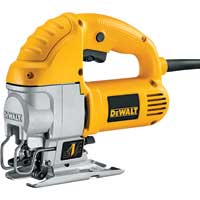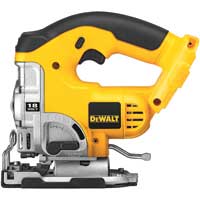|
Corded Jig Saw
Corded saws are available as single and variable speed models, some will include a light to aid in more accurate cuts. Variable speeds will range from 0 to 3000 strokes per minute. Many saws also offer orbital actions to allow faster more agressive cutting that can be set according to the material being cut.
Cordless Jig Saw
Cordless jig saws have all the features of corded models with the added advantage of not being limited to an available power outlet.18 volt models provide adequate power and long battery life, most brands use a common battery that works on their complete line of tools. Shop Jigsaws at Rockler.comJig Saw BladesThere are three basic styles of shanks that fasten the blade to the saw.
Jigsaw Blades at Rockler.com
Jig Saw SettingsFor cutting softwoods, softer hardwoods (poplar, mahogany, alder, etc.), and sheet goods, run your jigsaw at its highest speed. If you encounter resistance, back off the speed slightly. Denser woods, such as cherry, maple, oak, and walnut, require a slower speed to avoid burning. Use the slowest setting for cutting plastics and metals. If your jigsaw has an orbital setting set it to the greatest orbit for fast, but rough, cutting. Turn it off for cutting curves with less than a 3" radius. For large, sweeping curves, a little orbital action helps. Jig Saw SafetyNOTE: Never use a saw or any power tool while under the influence of drugs or alcohol. Read your owners manual for additional tips and safety features. 1. Wear safety goggles. 2. Tie back loose hair, tuck in long beards, and remove dangling jewelry or watches. 3. Make sure your sleeves are tight at your wrist, wearing long pants is recommended while wood working. 4. Use clamps to secure the cutting material to the work surface. 5. Always unplug and turn off the saw when you are changing or tightening the blade. Select the correct blade for each type of material you are cutting. Make sure your saw cutting speed is set for the type of material you are cutting, slower for metal, faster for wood, see manual for details. 6. Install the blade with the teeth facing the front of the saw. 7. It is best to drill a 3/8 inch pilot hole at the top edge of your circle to properly position your jig saw for cutting. Drill the hole where you want to start cutting and place the blade in the hole. 8. Never start the saw while the blade is touching the wood. 9. Do not start cutting until the blade is running at the proper speed. 10. Check under the cutting surface to make sure you have enough clearance for the blade to go up and down without hitting any thing. 11. Never reach in front of the saw or over the saw while the saw is operating.
|




